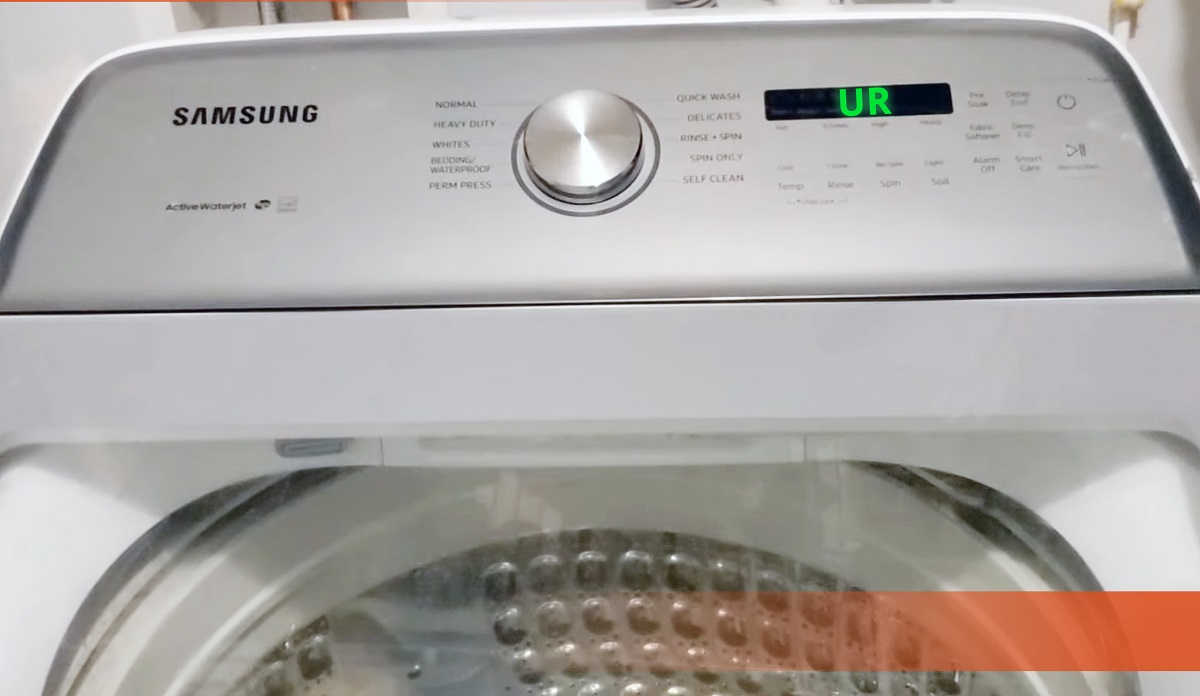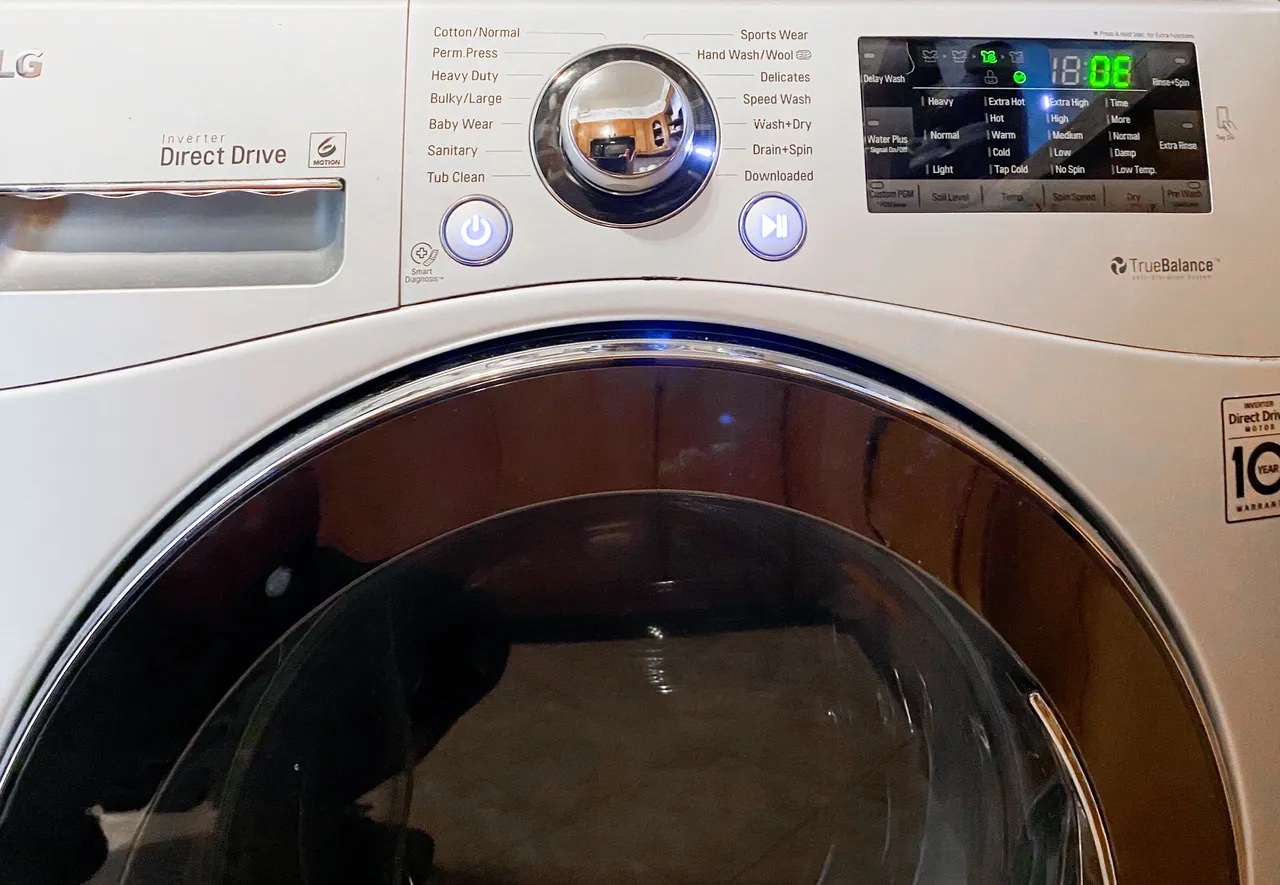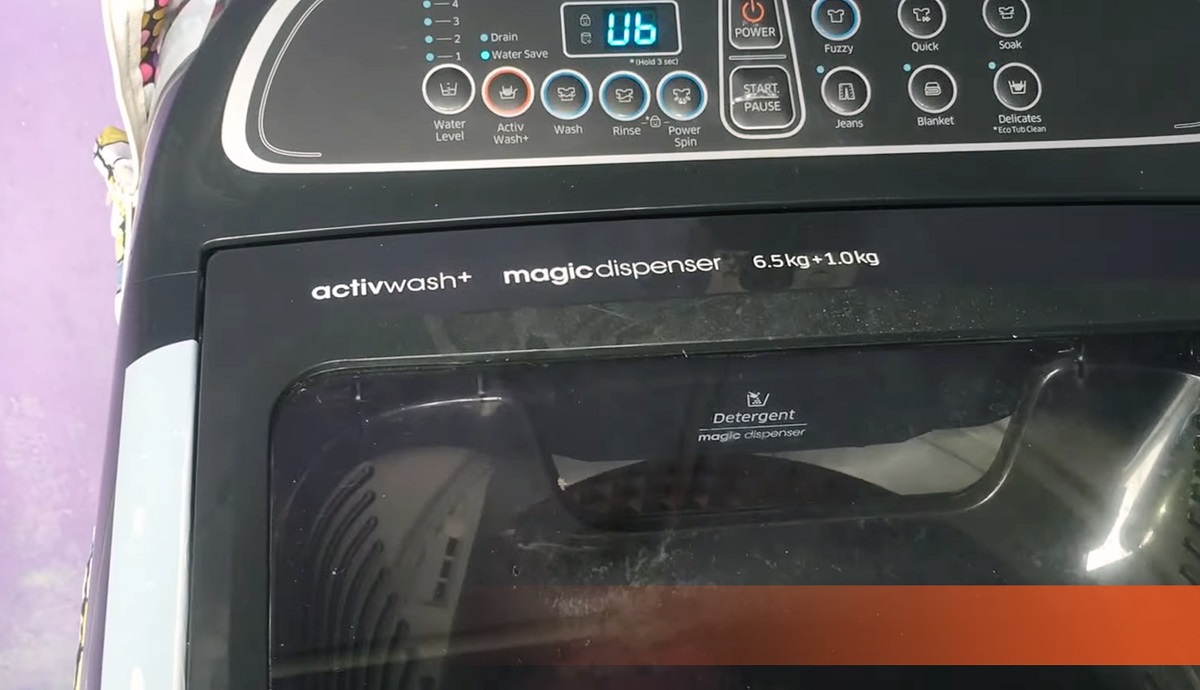Home>Home Appliances>Laundry Appliances>What Does Spin Mean In A Washing Machine


Laundry Appliances
What Does Spin Mean In A Washing Machine
Published: February 22, 2024
Discover what "spin" means in a washing machine and how it affects laundry appliances. Learn about the importance of spin cycles for efficient cleaning.
(Many of the links in this article redirect to a specific reviewed product. Your purchase of these products through affiliate links helps to generate commission for Storables.com, at no extra cost. Learn more)
Introduction
The spin cycle in a washing machine is a crucial stage of the laundry process, playing a pivotal role in ensuring that clothes emerge clean, fresh, and ready for the next step. Understanding the significance of the spin cycle and its impact on the overall laundry experience is essential for anyone seeking to optimize their washing machine's performance. From the removal of excess water to the preservation of fabric quality, the spin cycle is a fundamental aspect of modern laundry appliances. In this article, we will delve into the intricacies of the spin cycle, exploring its importance, factors affecting its efficiency, and practical tips for maximizing its effectiveness. Join us as we unravel the mysteries of the spin cycle and discover how it contributes to the art of achieving impeccably clean and well-cared-for garments.
Key Takeaways:
- The spin cycle in a washing machine expels water, reduces wrinkles, and saves energy, keeping clothes clean and fresh. Understanding and optimizing spin efficiency leads to better laundry results.
- Factors like spin speed, load balance, and maintenance affect spin efficiency. By following practical tips and considering these factors, users can maximize their washing machine’s performance for superior laundry outcomes.
Read more: What Does Delicate Mean On A Washer
Understanding the Spin Cycle
The spin cycle in a washing machine is a vital component of the laundry process, serving to extract excess water from the clothes after they have been thoroughly washed. Once the washing phase is complete, the machine transitions into the spin cycle, during which the drum rapidly rotates to expel the residual water from the fabric. This process is essential for reducing the moisture content in the garments, thereby expediting the drying process and ensuring that the clothes emerge from the machine damp rather than saturated.
The effectiveness of the spin cycle is determined by the speed at which the drum rotates. Higher spin speeds result in greater centrifugal force, facilitating more efficient water extraction. Modern washing machines are equipped with various spin speed settings, allowing users to tailor the intensity of the spin cycle to suit the specific requirements of different fabric types and laundry loads. Delicate garments may benefit from a gentler spin, while sturdier items such as towels and linens can withstand a more vigorous extraction process.
In addition to expelling water, the spin cycle also plays a crucial role in preventing the formation of wrinkles in the clothes. By removing excess moisture, the spin cycle minimizes the likelihood of garments becoming excessively creased during the drying phase, thereby reducing the need for extensive ironing. This not only saves time and effort but also helps to preserve the quality and appearance of the clothing.
Furthermore, the spin cycle contributes to the overall energy efficiency of the laundry process. By expelling a significant portion of the water from the garments, the spin cycle reduces the workload placed on the dryer, thereby decreasing the time and energy required to complete the drying phase. This not only translates to cost savings for the user but also aligns with sustainable practices by conserving energy resources.
In essence, the spin cycle is a pivotal stage in the washing machine's operation, serving to expel excess water, minimize wrinkles, and enhance energy efficiency. Understanding the significance of the spin cycle empowers users to make informed decisions regarding their laundry practices, ultimately contributing to the longevity and quality of their clothing while streamlining the overall laundry process.
Importance of Spin in Washing Machines
The spin cycle in washing machines holds immense significance in the realm of laundry care, playing a pivotal role in ensuring that garments emerge from the washing process clean, fresh, and primed for the subsequent steps. This critical phase of the laundry cycle is essential for several reasons, each contributing to the overall efficacy and quality of the washing machine's performance.
First and foremost, the spin cycle is instrumental in expelling excess water from the clothes following the washing phase. By rapidly rotating the drum, the washing machine generates centrifugal force, compelling the residual water to be extracted from the fabric. This process not only accelerates the subsequent drying phase but also prevents the clothes from emerging saturated, thereby expediting the overall laundry process.
Moreover, the spin cycle aids in preserving the integrity of the garments by minimizing the formation of wrinkles. By effectively removing excess moisture, the spin cycle reduces the likelihood of clothes becoming excessively creased during the drying process, thereby alleviating the need for extensive ironing. This not only saves time and effort for the user but also contributes to the preservation of the fabric's quality and appearance.
In addition to its impact on garment care, the spin cycle also plays a pivotal role in enhancing the energy efficiency of the laundry process. By expelling a significant portion of the water from the clothes, the spin cycle reduces the workload placed on the dryer, subsequently decreasing the time and energy required to complete the drying phase. This not only translates to cost savings for the user but also aligns with sustainable practices by conserving energy resources.
Furthermore, the spin cycle's ability to expel excess water from the garments contributes to the prevention of musty odors that can develop when clothes remain damp for prolonged periods. By facilitating efficient water extraction, the spin cycle aids in maintaining the freshness and cleanliness of the laundry, ensuring that the garments emerge from the washing machine free from residual odors and dampness.
In essence, the importance of the spin cycle in washing machines cannot be overstated. From expelling excess water and minimizing wrinkles to enhancing energy efficiency and preserving garment freshness, the spin cycle is a fundamental aspect of modern laundry appliances, contributing to the overall efficacy and quality of the laundry process. Understanding and appreciating the significance of the spin cycle empowers users to optimize their washing machine's performance, ultimately contributing to the longevity and quality of their clothing while streamlining the overall laundry experience.
Factors Affecting Spin Efficiency
Several factors influence the efficiency of the spin cycle in washing machines, ultimately impacting the machine's ability to extract water from the garments effectively. Understanding these factors is crucial for optimizing the washing machine's performance and achieving superior laundry results. Here are the key elements that can significantly affect spin efficiency:
1. Spin Speed Settings
The spin speed selected for a particular laundry load directly impacts the efficiency of the spin cycle. Higher spin speeds generate greater centrifugal force, leading to more effective water extraction. However, it is essential to consider the fabric type and garment care labels when choosing the spin speed, as delicate items may require a gentler spin to prevent damage.
Read more: What Does De Mean On Washer
2. Load Balance
The distribution of the laundry load within the washing machine drum is critical for optimal spin efficiency. Unevenly distributed or overloaded loads can lead to imbalanced spinning, reducing the effectiveness of water extraction. Ensuring a balanced load placement within the drum promotes smoother and more efficient spinning, enhancing the overall spin cycle performance.
3. Machine Maintenance
Regular maintenance of the washing machine, including drum cleaning and maintenance checks, is essential for preserving spin efficiency. Accumulated debris, lint, or mineral deposits can impede the smooth rotation of the drum, diminishing the effectiveness of the spin cycle. Keeping the machine clean and well-maintained is vital for ensuring consistent spin performance.
4. Fabric Type and Absorbency
The absorbency of different fabric types can impact spin efficiency. Highly absorbent fabrics, such as towels and cotton, retain more water, requiring a more robust spin cycle for effective water extraction. Understanding the absorbency of various fabrics and adjusting the spin settings accordingly can significantly enhance spin efficiency.
5. Machine Age and Technology
The age and technological capabilities of the washing machine can influence spin efficiency. Modern machines equipped with advanced spin technology may offer enhanced water extraction capabilities compared to older models. Upgrading to a newer, more efficient washing machine can contribute to improved spin performance and overall laundry efficiency.
By considering these factors and implementing appropriate measures, users can optimize the spin efficiency of their washing machines, leading to superior water extraction, reduced drying times, and impeccably clean and well-cared-for garments. Understanding the nuances of spin efficiency empowers users to make informed decisions regarding their laundry practices, ultimately enhancing the overall effectiveness and quality of the laundry process.
Read more: What Does Dl Mean On A Washer
Tips for Maximizing Spin Efficiency
-
Proper Load Distribution: Ensure that the laundry load is evenly distributed within the washing machine drum. An imbalanced load can hinder the effectiveness of the spin cycle, leading to suboptimal water extraction. By arranging the garments evenly, you can promote smoother and more efficient spinning, ultimately enhancing spin cycle performance.
-
Select Appropriate Spin Speed: When loading the washing machine, consider the fabric type and garment care labels to determine the ideal spin speed. Delicate items may require a gentler spin, while sturdier fabrics can withstand higher spin speeds for more effective water extraction. Choosing the appropriate spin speed setting for each load can significantly enhance spin efficiency.
-
Regular Maintenance: Keep the washing machine clean and well-maintained to preserve spin efficiency. Regular drum cleaning and maintenance checks are essential for ensuring consistent spin performance. Removing debris, lint, and mineral deposits from the drum can prevent obstructions that may impede the smooth rotation during the spin cycle.
-
Optimize Load Size: Avoid overloading the washing machine, as this can compromise spin efficiency. By optimizing the load size according to the machine's capacity, you can ensure that the drum can effectively accommodate the garments, promoting efficient water extraction during the spin cycle.
-
Use High-Quality Detergents: Utilize high-quality detergents that are specifically formulated for modern washing machines. These detergents are designed to facilitate effective cleaning and rinsing, which can contribute to improved spin efficiency by minimizing residue buildup that may impede water extraction.
-
Pre-Treat Stains: Addressing stains and heavily soiled areas before loading the garments into the washing machine can enhance spin efficiency. By pre-treating stains, you can facilitate more thorough cleaning during the wash cycle, reducing the likelihood of residual dirt impeding the spin cycle's effectiveness.
-
Monitor Fabric Absorbency: Consider the absorbency of different fabric types when setting the spin speed. Highly absorbent fabrics require a more robust spin to ensure effective water extraction. By adjusting the spin settings based on fabric absorbency, you can optimize spin efficiency for various types of garments.
-
Upgrade to Advanced Technology: If feasible, consider upgrading to a newer washing machine equipped with advanced spin technology. Modern machines may offer enhanced spin capabilities, leading to superior water extraction and overall laundry efficiency.
By implementing these tips, users can maximize the spin efficiency of their washing machines, resulting in superior water extraction, reduced drying times, and impeccably clean and well-cared-for garments. These practical measures empower users to optimize their laundry practices, ultimately enhancing the overall effectiveness and quality of the laundry process.
Conclusion
In conclusion, the spin cycle in a washing machine is far more than just a stage in the laundry process; it is a critical determinant of the overall efficacy and quality of garment care. From expelling excess water and minimizing wrinkles to enhancing energy efficiency and preserving garment freshness, the significance of the spin cycle cannot be overstated.
Understanding the intricacies of the spin cycle empowers users to make informed decisions regarding their laundry practices, ultimately contributing to the longevity and quality of their clothing while streamlining the overall laundry experience. By recognizing the factors that influence spin efficiency and implementing practical tips for maximizing its effectiveness, users can optimize their washing machine's performance, leading to superior water extraction, reduced drying times, and impeccably clean and well-cared-for garments.
The spin cycle's ability to expel excess water, prevent wrinkles, and enhance energy efficiency aligns with the modern-day pursuit of sustainable and efficient living. By leveraging the spin cycle's capabilities, users can minimize water and energy consumption while ensuring that their garments emerge from the washing machine fresh, clean, and ready for the next step in the laundry process.
As technology continues to advance, washing machines are likely to incorporate even more sophisticated spin cycle features, further enhancing water extraction and garment care. By staying informed about these advancements and embracing the best practices for spin efficiency, users can continue to elevate their laundry experience, achieving exceptional results while preserving the quality and longevity of their clothing.
In essence, the spin cycle is not merely a mechanical process; it is a cornerstone of modern laundry care, embodying the fusion of technology, efficiency, and garment preservation. By recognizing its importance and optimizing its performance, users can embark on a journey towards a more sustainable, effective, and rewarding laundry experience, where clean, fresh, and well-cared-for garments are the hallmark of every wash cycle.
Frequently Asked Questions about What Does Spin Mean In A Washing Machine
Was this page helpful?
At Storables.com, we guarantee accurate and reliable information. Our content, validated by Expert Board Contributors, is crafted following stringent Editorial Policies. We're committed to providing you with well-researched, expert-backed insights for all your informational needs.














0 thoughts on “What Does Spin Mean In A Washing Machine”